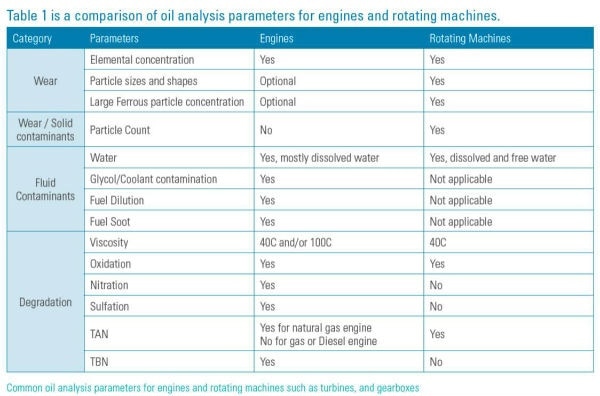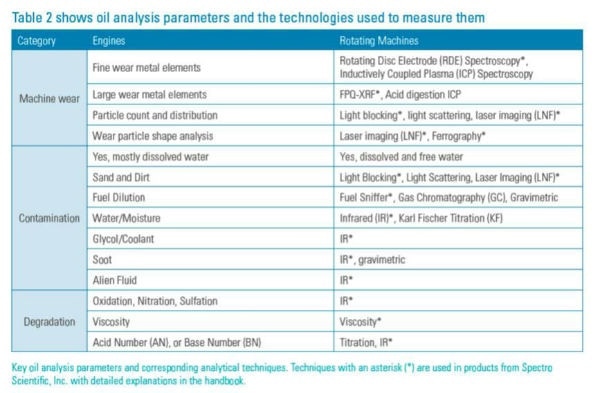Over a century ago, the practice of used oil analysis or in-service oil analysis began on locomotive engines. Today, it is one of the most vital parts of condition based maintenance (CBM), a practice of assessing a machine’s condition by collecting data on key machine health indicators periodically, in order to establish maintenance schedules.
Each year, billions of dollars are spent replacing machinery components which have worn out as a result of insufficient lubricant performance. Knowing how to interpret fluctuating lubricant characteristics can enhance both the life and uptime the of application critical assets. The existence or volume of particles and debris from erosion, wearing parts, and contamination supply insights regarding the issues influencing reliability and performance.
Fuels, lubricants, and other key fluid analyses supply crucial early warning information which is indicative of machine failure. It is possible to schedule maintenance before a critical failure happens by analyzing and trending data. The results are lower maintenance costs, higher equipment availability and productivity, optimal equipment performance, lower total cost of ownership (TCO), fewer outages, and operation which is greener.
What is In-service Oil Analysis?
Lubricating oil is the life blood of oil wetted machinery. In-service oil analysis can supply information regarding machine wear condition, lubricant contamination and lubricant condition (Figure 1). Based on the diagnoses of oil analysis results, maintenance professionals and reliability engineers can make decisions regarding maintenance.
Machine wear analysis is basically the analysis of particles in the oil. Machine wear can be classified into abrasive (cutting) wear, adhesive (sliding) wear, corrosive wear, and fatigue wear. A total wear particle analysis consists of wear metal and alloy elements, particle shape and morphology, measure of particle count and distribution, and presence of large ferrous particles.
Different methods and tools have been used in commercial laboratories or in the field over the years, but essentially they all supply the aforementioned information. Certain issues are different for rotating engines than from industrial rotating machines, even though all wear particle analysis methods can be applied to different types of assets.
Engine oils can be dark due to soot (nano-sized carbon particles as combustion byproduct) and reciprocal engines tend to produce fine wear particles. Elemental analysis is the first, or sometimes the only, analysis carried out in a commercial oil lab which determines engine wear conditions, because concentrations of different wear metal elements establish wear severity of moving parts in an engine.
Slower moving rotating machines, like gearboxes, usually produce larger wear particles. Large ferrous particle analysis is fairly common and simple to execute on oils from these assets as most of them are made of steel.
Contaminants in oil exist in liquid or solid form. Solid contaminants like dirt and sand are typically monitored by particle counting and sizing techniques. Liquid contaminant for industrial rotating machines is mainly water. However, for gas or diesel engines, it can be coolant, water, or fuel.
Across all asset types, a common fluid contaminant is the purposeful or accidental utilization of an incorrect lubricant whilst topping off old oil. All contaminants can decrease the useful life of the oil and increase machine wear considerably. They must be prevented proactively with proper seals and filtration systems and they should be regularly monitored.
Monitoring lubricant degradation assists in deciding if the oil is no longer fit for use and if it has to be changed. Viscosity is a key property of oil, it is usually measured at 100 °C for engines and 40 °C for rotating machines.
Acidity and oxidation of the oil (Total Acid Number or TAN) are monitored for oil in rotating machines. This is to establish if the oil is still fit for use and to prevent corrosion. For engine oils, nitration, sulfation, oxidation, and total alkaline additive reserve in oil (Total Base Number or TBN) are monitored. For natural gas engine oils, TAN is monitored, plus other engine oil parameters.
Benefits of In-Service Oil Analysis
The main advantages of in-service oil analysis are productivity increases and maintenance cost savings from improving the uptime of running machines. If the correct oils are utilized and the oils are clean, dry, and fit for use then machines run longer.
One of the most common lubrication issues contributing to machine failure is oil mix up. Using the proper lubricating oil in a machine is a simple task which can enhance machine reliability. Checking the brand, viscosity, and grade of an oil and checking for contamination of alien fluids will help to decrease the possibility of oil mix up and keep the machines running at maximum efficiency.
Filtration systems and seals must work properly and oils need to be checked regularly in order to keep the oil dry, clean and free of contaminants. Coolant or fuel in engine oil alters viscosity and leads to the generation of adhesive wear. Moisture in oil causes corrosion. Dirt and sand in oil causes abrasive wear. It is necessary to keep the lubricating oil dry and clean at all times.
Oil conditions should be monitored frequently to ensure the oil is used within its performance specification to keep it fit for use. A well balanced oil analysis program should monitor oil degradation, oil contamination, and machine wear condition.
Key parameters are measured regularly, and their trends are closely monitored. If any of the parameters surpass the alarm limits or an alteration in the trending rate is identified, reliability engineers are alerted and maintenance actions may be required to resolve possible problems.
The cost savings from a well-executed oil analysis program derive from decreasing production loss from unplanned downtime because of catastrophic failure plus lowering repair costs and stopping unnecessary oil changes. In a paper mill or power plant, the majority of cost savings come from decreased machine down time and repairs.
In the instance of a mining site possessing hundreds of hauling trucks, the majority of cost savings come from preventing engine failures. However, for a municipal transportation fleet, the cost savings from oil analysis are a result of less labor, material, and recycling by increasing the oil drain intervals.



This information has been sourced, reviewed and adapted from materials provided by AMETEK Spectro Scientific.
For more information on this source, please visit AMETEK Spectro Scientific.